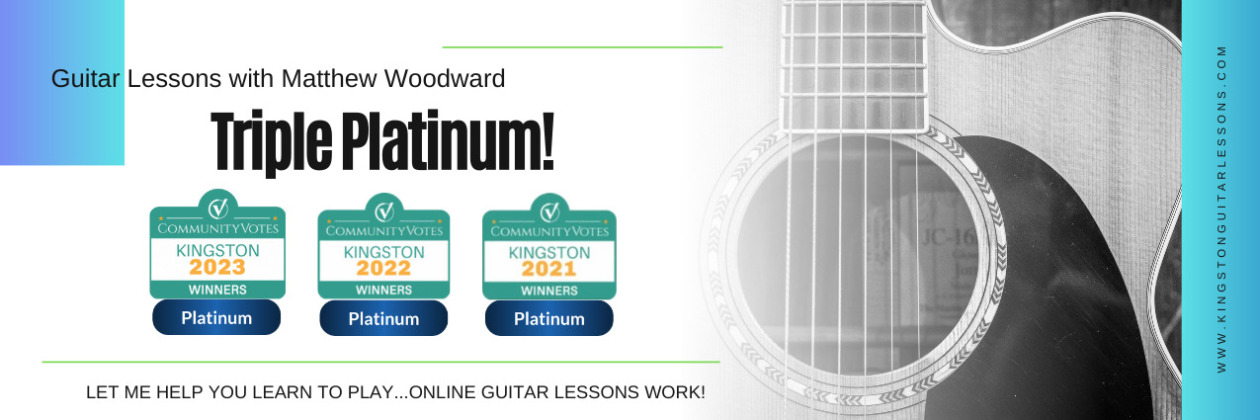In my experience as a guitar instructor I have met two different types of students – those who know which way is up, and those who…well…don’t.
I’m referring to how a guitarist “sees” his or her instrument when viewing it from the playing position. Some players describe locations on their instrument with reference to the room they are in. Others, like myself, take a more musical point of view on things.
Grab your guitar. See that big 6th string that’s closest to you? It’s also the closest string to the sky, so some people refer to it as the “top string”, and the skinniest string, closest to the floor as their “bottom string”. This way of thinking always messes me up because, for me, the big string is THE BOTTOM STRING and the skinny one is THE TOP STRING. Why? My orientation is not based on the room I’m in, but rather the musical pitches that each of those strings are tuned to. I think in terms of high and low musically. Lie on your back while playing guitar and you’ll see how the first concept fails, while the melodic idea does not. The pitch of the 1st string remains high above that of the 6th.
Our sixth string, tuned to E, sounds the lowest note available to us in standard tuning. I think of that low E as being at the bottom of things, below every other note on the guitar. As we move from the 6th string to the 5th string I think of that as a jump upward, because the 5th string is tuned to a higher pitch than the 6th. The other strings sound consecutively higher pitches, so I consider moving from the 6th string towards the 1st string as going UP across the strings, ie. from the low side to the high side.
Directionally, I always think in terms of pitch. If I’m holding an open E major chord and hit just strings 6, 5 and 4, I have just played the bottom half of the chord. I might just chug away on that low end, occasionally spanking those higher strings on accents. Think of the riff to the T. Rex song “Bang A Gong (Get It On)”.
Now let us consider these concepts of up and down with respect to a single string. Play your open low E (Ha!). As stated, the full-length of the open string sounds the lowest pitch of that string. Now press the string down against the 1st fret and note how the pitch we hear is now higher. By fretting the string you have shortened its length, which causes it to sound out a higher pitch. The shorter the string becomes, the higher the pitch goes, so, if you continue moving to consecutively higher frets you will be heading in the direction that I refer to as “up the neck”. Moving from the area of your headstock towards the body of your guitar is moving upward, and this holds true for all of your strings.
To summarize and take it just a bit farther, we actually end up with TWO ways to go when we wish to change from low notes to high notes: First we had the idea of moving upwards across the fretboard from our 6th string to our 1st; secondly, by shortening any string by fretting notes we can move up the neck. As a result, in a general sense, movement from low to high on the guitar is in a diagonal path that runs from the low open 6th string to the note sounded by using the highest fret available on the 1st string (which varies between instruments).
If I haven’t yet convinced you to change your ways, then consider how musical notes are written on sheet music and tablature staves, where low notes are placed on the lower lines and higher ones on the lines above them. Even if you don’t read, you can see from the example below how the melody of the picking pattern, which moves from low notes to high notes and then back to low, takes the shape of a curve that also moves up and back down as though it climbs up a hill to the top and then comes back down on the other side. On both the music and tablature staves you can see the shape of the melody rising and falling. A single strum across the entire G chord ends the melody. Its notes are stacked, because they are all played at the same time. See where the notes of the chord are found on the staves, relate them to your guitar, and think about high and low.
It is very common for musicians to discuss the direction of melodies or chord progressions, or the relationship between particular notes by using descriptive terms such as low, high, up, down, top, bottom, between, leaping upward, over, below, rising, falling, droning beneath, soaring above, ascending, descending, etc.
It only makes sense that your understanding of the guitar should be in keeping with this pitch-oriented, musical approach.
Let that be a lesson to you. ![]()
© 2014 Matthew Woodward


